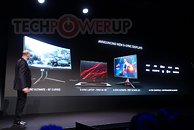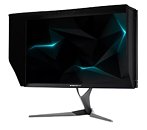Mar 29th, 2025 07:42 EDT
change timezone
Latest GPU Drivers
New Forum Posts
- What are you playing? (23306)
- Upgrade from a AMD AM3+ to AM4 or AM5 chipset MB running W10? (15)
- RTX 5080 - performance fluctuation (6)
- Future-proofing my OLED (56)
- Did Nvidia purposely gimp the performance of 50xx series cards with drivers (114)
- AMD RX 9070 XT & RX 9070 non-XT thread (OC, undervolt, benchmarks, ...) (71)
- TPU's F@H Team (20414)
- Have you got pie today? (16650)
- Which thermal paste never pumps out? (67)
- Is RX 9070 VRAM temperature regular value or hotspot? (264)
Popular Reviews
- Sapphire Radeon RX 9070 XT Pulse Review
- Samsung 9100 Pro 2 TB Review - The Best Gen 5 SSD
- ASRock Phantom Gaming B850 Riptide Wi-Fi Review - Amazing Price/Performance
- Assassin's Creed Shadows Performance Benchmark Review - 30 GPUs Compared
- be quiet! Pure Rock Pro 3 Black Review
- Sapphire Radeon RX 9070 XT Nitro+ Review - Beating NVIDIA
- ASRock Radeon RX 9070 XT Taichi OC Review - Excellent Cooling
- Palit GeForce RTX 5070 GamingPro OC Review
- Pulsar Feinmann F01 Review
- AMD Ryzen 7 9800X3D Review - The Best Gaming Processor
Controversial News Posts
- AMD RDNA 4 and Radeon RX 9070 Series Unveiled: $549 & $599 (260)
- MSI Doesn't Plan Radeon RX 9000 Series GPUs, Skips AMD RDNA 4 Generation Entirely (142)
- Microsoft Introduces Copilot for Gaming (123)
- AMD Radeon RX 9070 XT Reportedly Outperforms RTX 5080 Through Undervolting (118)
- NVIDIA Reportedly Prepares GeForce RTX 5060 and RTX 5060 Ti Unveil Tomorrow (115)
- Over 200,000 Sold Radeon RX 9070 and RX 9070 XT GPUs? AMD Says No Number was Given (100)
- NVIDIA GeForce RTX 5050, RTX 5060, and RTX 5060 Ti Specifications Leak (96)
- Retailers Anticipate Increased Radeon RX 9070 Series Prices, After Initial Shipments of "MSRP" Models (90)
News Posts matching #quantum-dot
Return to Keyword Browsing
ViewSonic ELITE Launches New 32" Gaming Monitors with the Latest Gamer-Centric Technologies
A leading global provider of visual solutions, ViewSonic Corp., announces a new collection of ViewSonic ELITE 32" professional gaming monitors geared up with the latest display technologies. The new models allow gamers to experience next-level gaming with quantum-dot technology on the class-leading ELITE XG320Q monitor, extract the full potential of next gen consoles with the ELITE XG320U with HDMI 2.1 capabilities, or enter true cinematic immersion with the flagship Mini-LED-backlit ELITE XG321UG.
"At ViewSonic ELITE, we continuously seek to deliver high-end gaming monitors to suit every gamer from enthusiast to professional. While 27" monitors are typical for mainstream gaming, we recognized the demand for widescreens and expanded our 32" product line," says Oscar Lin, Head of Monitor Business Unit at ViewSonic. "Equipped with cutting-edge technologies to revolutionize the way gamers see, play, and experience games, the ELITE 32" monitor series deliver an immersive viewing experience alongside ultra-smooth gameplay and incredible color accuracy."
"At ViewSonic ELITE, we continuously seek to deliver high-end gaming monitors to suit every gamer from enthusiast to professional. While 27" monitors are typical for mainstream gaming, we recognized the demand for widescreens and expanded our 32" product line," says Oscar Lin, Head of Monitor Business Unit at ViewSonic. "Equipped with cutting-edge technologies to revolutionize the way gamers see, play, and experience games, the ELITE 32" monitor series deliver an immersive viewing experience alongside ultra-smooth gameplay and incredible color accuracy."

Samsung Electronics Announces Second Quarter 2021 Results
Samsung Electronics today reported financial results for the second quarter ended June 30, 2021. Total consolidated revenue was KRW 63.67 trillion, a 20% increase from the previous year and a record for the second quarter. Operating profit increased 34% from the previous quarter to KRW 12.57 trillion as market conditions improved in the memory market, operations normalized at the Austin foundry fab, and as effective global supply chain management (SCM) helped maintain solid profitability for the finished product businesses.
The Semiconductor business saw a significant improvement in earnings as memory shipments exceeded previous guidance and price increases were higher than expected, while the Company strengthened its cost competitiveness. For the Display Panel Business, a one-off gain and an increase in overall prices boosted profits.
The Semiconductor business saw a significant improvement in earnings as memory shipments exceeded previous guidance and price increases were higher than expected, while the Company strengthened its cost competitiveness. For the Display Panel Business, a one-off gain and an increase in overall prices boosted profits.

ASUS Announces ProArt Display PA32UCX-P and PA27UCX
ASUS today announced ProArt Display PA32UCX-P and PA27UCX, 4K HDR monitors for professional content creators with groundbreaking Off-Axis Contrast Optimization (OCO) technology that maintains color accuracy in wide-angle viewing and makes the monitors ideal collaboration tools. The 32-inch PA32UCX-P and 27-inch PA27UCX feature mini-LED backlighting and support for multiple HDR formats, including Dolby Vision, HDR10 and Hybrid Log Gamma (HLG). PA32UCX-P offers a peak brightness of 1200 cd/m² with 1152 zones of local dimming control, and PA27UCX offers a peak brightness of 1000 cd/m² with 576 zones.
Designed to give content creators professional-grade color performance, PA32UCX-P and PA27UCX come pre-calibrated and provide a Delta-E (ΔE) color accuracy of less than one in the sRGB and Adobe RGB color spaces. They also feature quantum-dot technology that supports the DCI-P3, Rec. 709, Rec. 2020, sRGB and Adobe RGB color spaces. For seamless calibration, the monitors are compatible with most major calibrators and professional calibration software.
Designed to give content creators professional-grade color performance, PA32UCX-P and PA27UCX come pre-calibrated and provide a Delta-E (ΔE) color accuracy of less than one in the sRGB and Adobe RGB color spaces. They also feature quantum-dot technology that supports the DCI-P3, Rec. 709, Rec. 2020, sRGB and Adobe RGB color spaces. For seamless calibration, the monitors are compatible with most major calibrators and professional calibration software.

Samsung to End LCD Manufacturing by Late-2020, Focus on AMOLED and QLED
Samsung Display, a subsidiary of Samsung Electronics that develops and manufactures display panels, is reportedly ending the manufacturing of all its LCD panel products by the end of 2020. These include TN-film, various kinds of VA, and IPS. This would see an end to even LED-backlit LCD panels that make up a bulk of the company's low-cost PC monitors and TVs. The company will focus on more advanced panel technologies, such as AMOLED and QLED. Samsung manufactures LCD panels at plants in South Korea and China. With LCD being phased out, the production lines will be re-tooled to manufacture quantum-dot LED (QLED) panels. The company will spend the rest of 2020 shipping out pending orders of LCD panels.

ASUS Announces Mini-LED Powered ROG Swift PG27UQX G-Sync Ultimate Monitor
ASUS in partnership with NVIDIA announced at COMPUTEX 2019 their first Mini-LED powered PC monitor, which promises to bring the dimming zone game up to an unprecedented level - at least, on IPS technology. The usage of Mini-LED as lighting source for the ROG Swift PG27UQX means that there are many more areas that can be dimmed and brightened according to the displayed content: 576 of them, really, with each being comprised of mini LEDs that are a mere 200-300 micrometers in size.
The ROG Swift PG27UQX features a 27" panel with HDR support (HDR 1000 certification with up to 1,000 nits brightness). It's overclockable to a 144 Hz refresh rate, and color-wise offers DCI-P3 97% and Adobe RGB with quantum-dot technology for 99% coverage. ASUS says that the local dimming capabilities also allow for lower energy consumption (which does make sense). Connector-wise, we're looking at DisplayPort v1.4, HDMI (v2.0), 3x USB 3.0 and 1x 3.5 mm earphone jack. Being a G-Sync Ultimate panel, it features NVIDIA's latest G-Sync processor, which should bringing pricing to even higher levels than you are already expecting.
The ROG Swift PG27UQX features a 27" panel with HDR support (HDR 1000 certification with up to 1,000 nits brightness). It's overclockable to a 144 Hz refresh rate, and color-wise offers DCI-P3 97% and Adobe RGB with quantum-dot technology for 99% coverage. ASUS says that the local dimming capabilities also allow for lower energy consumption (which does make sense). Connector-wise, we're looking at DisplayPort v1.4, HDMI (v2.0), 3x USB 3.0 and 1x 3.5 mm earphone jack. Being a G-Sync Ultimate panel, it features NVIDIA's latest G-Sync processor, which should bringing pricing to even higher levels than you are already expecting.
4K Ultra HD Monitors with 144 Hz Refresh-rate and G-SYNC HDR Start Being Available
As we reported in March, the first 4K monitors with 144 Hz refresh-rate began showing up in stores. This summer, PC gamers and enthusiasts up for a monitor upgrade, are in for a treat. An increasing number of companies are preparing to launch monitors with not just 4K Ultra HD resolution (3840 x 2160 pixels), but also staggering 144 Hz refresh-rates, and support for adaptive sync technologies, such as AMD FreeSync and NVIDIA G-Sync. To push 4K at 144 Hz, you'll need your graphics card to feature DisplayPort 1.4 (or above) connectivity, as DisplayPort 1.2, or even the newer HDMI 2.0, lack the required bandwidth.
Among the first blazing fast 4K UHD + 144 Hz monitors, are the 2018 Acer Predator X27 (UM.HX0EE.009) first unveiled in 2017, and soon to be joined by the ASUS ROG Swift PG27UQ. Both monitors feature 4K Ultra HD resolution, 144 Hz refresh-rate, IPS quantum-dot panels, and support for the new NVIDIA G-SYNC HDR standard. The monitors take input from DisplayPort 1.4 and HDMI 2.0, although you will need DisplayPort 1.4 to get 4K @ 144 Hz to work correctly. The IPS quantum-dot panels feature DCI-P3 color-standards, 99% Adobe RGB coverage, and 10 bpc (1.07 billion-color) palette, in addition to 384 LED elements backlighting the panel. The ROG Swift PG27UQ starts at 2,445€ and the Predator X27 at 18,475 DKK Sounds good? Get ready to foot upwards of USD $3,000 for either of them, to go with your $3,000 TITAN V, for a 3,000-inch e-p.
Among the first blazing fast 4K UHD + 144 Hz monitors, are the 2018 Acer Predator X27 (UM.HX0EE.009) first unveiled in 2017, and soon to be joined by the ASUS ROG Swift PG27UQ. Both monitors feature 4K Ultra HD resolution, 144 Hz refresh-rate, IPS quantum-dot panels, and support for the new NVIDIA G-SYNC HDR standard. The monitors take input from DisplayPort 1.4 and HDMI 2.0, although you will need DisplayPort 1.4 to get 4K @ 144 Hz to work correctly. The IPS quantum-dot panels feature DCI-P3 color-standards, 99% Adobe RGB coverage, and 10 bpc (1.07 billion-color) palette, in addition to 384 LED elements backlighting the panel. The ROG Swift PG27UQ starts at 2,445€ and the Predator X27 at 18,475 DKK Sounds good? Get ready to foot upwards of USD $3,000 for either of them, to go with your $3,000 TITAN V, for a 3,000-inch e-p.

Samsung to Showcase its First MicroLED Display Implementation at CES
If 2015 was all about OLED, and 2016-17 about quantum-dot (QLED), Samsung will herald the MicroLED display panel era in 2018, with its first implementation, a massive 150-inch television, which will be showcased at the 2018 International CES. A MicroLED panel uses solid-state LED elements etched onto a silicon-substrate, that are less than 100 µm in size, each, which act as individual pixels. If you're familiar with microscopic transistors that make up modern semiconductor chips, imagine if LEDs were built on that scale. That's MicroLED.
With further development, MicroLED panels will achieve higher pixel densities, and won't suffer form "burn-in" problems that OLED (organic LED) panels suffer from displaying the same image over extended periods of time. It also offers significantly lower power-draw compared to OLED. The 150-inch MicroLED TV prototype Samsung is showing off at CES will come with 4K Ultra HD resolution. Samsung's next implementation of the MicroLED tech could be smartphone display panels. The company's main rival in this area, Apple, is already working with TSMC to develop MicroLED panels of its own.
With further development, MicroLED panels will achieve higher pixel densities, and won't suffer form "burn-in" problems that OLED (organic LED) panels suffer from displaying the same image over extended periods of time. It also offers significantly lower power-draw compared to OLED. The 150-inch MicroLED TV prototype Samsung is showing off at CES will come with 4K Ultra HD resolution. Samsung's next implementation of the MicroLED tech could be smartphone display panels. The company's main rival in this area, Apple, is already working with TSMC to develop MicroLED panels of its own.

NVIDIA Announces the G-SYNC HDR Technology
NVIDIA today announced the G-SYNC HDR technology. An evolution of the company's proprietary adaptive display sync technology, which keeps the display's refresh-rates dynamically in-sync with the graphics card's frame-rates, G-SYNC HDR, as its name suggests, adds support for HDR (high dynamic range) displays. NVIDIA's partner display manufacturers such as Acer, and ASUS have each announced displays with this technology, which will will be available later this year.
NVIDIA worked with display panel maker AUOptronics to develop G-SYNC HDR. It leverages full 384-zone LED backlights, and a quantum-dot technology. The monitors rely on wide color gamuts, with 10-bit (1.07 billion color palettes) to bring HDR to life. G-SYNC HDR monitors come with support for the HDR10 standard. The year's most anticipated game, "Mass Effect: Andromeda," will come with support for G-SYNC HDR.
NVIDIA worked with display panel maker AUOptronics to develop G-SYNC HDR. It leverages full 384-zone LED backlights, and a quantum-dot technology. The monitors rely on wide color gamuts, with 10-bit (1.07 billion color palettes) to bring HDR to life. G-SYNC HDR monitors come with support for the HDR10 standard. The year's most anticipated game, "Mass Effect: Andromeda," will come with support for G-SYNC HDR.

Samsung Unveils CH711 Curved Quantum-dot Monitor
At CES 2017, Samsung Electronics plans to demonstrate how it has stepped up its game in the entertainment monitor space with the unveiling of its new CH711 Quantum Dot Curved monitor. Additionally, Samsung will also showcase its recently launched CFG70 and CF791 Quantum Dot displays at the Las Vegas Convention Center, Booth #15006, Central Hall.
"Today's multimedia consumers have heightened expectations; they demand an immersive experience that makes them feel like they're part of the games they play and the content they view," said Andrew Sivori, Vice President, CE-IT Product Marketing at Samsung Electronics America. "Our new Quantum Dot Curved monitors offer brilliant design, richer color, and even deeper contrast than ever before."
"Today's multimedia consumers have heightened expectations; they demand an immersive experience that makes them feel like they're part of the games they play and the content they view," said Andrew Sivori, Vice President, CE-IT Product Marketing at Samsung Electronics America. "Our new Quantum Dot Curved monitors offer brilliant design, richer color, and even deeper contrast than ever before."
Mar 29th, 2025 07:42 EDT
change timezone
Latest GPU Drivers
New Forum Posts
- What are you playing? (23306)
- Upgrade from a AMD AM3+ to AM4 or AM5 chipset MB running W10? (15)
- RTX 5080 - performance fluctuation (6)
- Future-proofing my OLED (56)
- Did Nvidia purposely gimp the performance of 50xx series cards with drivers (114)
- AMD RX 9070 XT & RX 9070 non-XT thread (OC, undervolt, benchmarks, ...) (71)
- TPU's F@H Team (20414)
- Have you got pie today? (16650)
- Which thermal paste never pumps out? (67)
- Is RX 9070 VRAM temperature regular value or hotspot? (264)
Popular Reviews
- Sapphire Radeon RX 9070 XT Pulse Review
- Samsung 9100 Pro 2 TB Review - The Best Gen 5 SSD
- ASRock Phantom Gaming B850 Riptide Wi-Fi Review - Amazing Price/Performance
- Assassin's Creed Shadows Performance Benchmark Review - 30 GPUs Compared
- be quiet! Pure Rock Pro 3 Black Review
- Sapphire Radeon RX 9070 XT Nitro+ Review - Beating NVIDIA
- ASRock Radeon RX 9070 XT Taichi OC Review - Excellent Cooling
- Palit GeForce RTX 5070 GamingPro OC Review
- Pulsar Feinmann F01 Review
- AMD Ryzen 7 9800X3D Review - The Best Gaming Processor
Controversial News Posts
- AMD RDNA 4 and Radeon RX 9070 Series Unveiled: $549 & $599 (260)
- MSI Doesn't Plan Radeon RX 9000 Series GPUs, Skips AMD RDNA 4 Generation Entirely (142)
- Microsoft Introduces Copilot for Gaming (123)
- AMD Radeon RX 9070 XT Reportedly Outperforms RTX 5080 Through Undervolting (118)
- NVIDIA Reportedly Prepares GeForce RTX 5060 and RTX 5060 Ti Unveil Tomorrow (115)
- Over 200,000 Sold Radeon RX 9070 and RX 9070 XT GPUs? AMD Says No Number was Given (100)
- NVIDIA GeForce RTX 5050, RTX 5060, and RTX 5060 Ti Specifications Leak (96)
- Retailers Anticipate Increased Radeon RX 9070 Series Prices, After Initial Shipments of "MSRP" Models (90)














